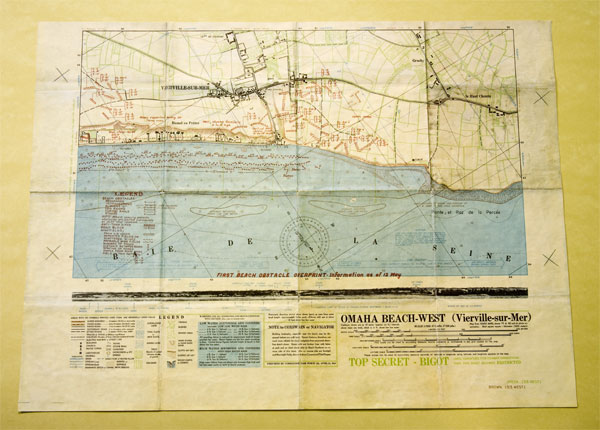Map (reproduction)
1944
Omaha Beach-West (Vierville-sur-Mer), Normandy, France
This map was prepared by commander Task Force 122, April 21, 1944. It shows obstacles constructed by Germans in brown, vegetation in green, water in blue, and towns and roads in black, with a key and narrative, as well as sunlight and moonlight tables from 5/25 - 6/21/1944 and tidal stages charts printed on reverse.
Operation Overlord
Operation Overlord, D-Day, June 6, 1944, was a crucial battle in World War II. Allied forces under the command of General Dwight D. Eisenhower assaulted German defenses along a 45 mile swath of the coast of occupied Normandy France. The plan called for landings on five stretches of beach code named Utah, Omaha, Gold, Juno, and Sword. Some 132,000 American, British, Canadian, and Free French soldiers, were ferried across the English Channel by the Allied navies. Approximately ten miles out from the beaches they began their assault aboard landing craft, coming in at low tide. The first landings were scheduled to begin at H-Hour, 6:30, that morning.
In the initial attack, the V Corps was represented at Omaha Beach by units of the 1st and 29th Infantry Divisions, as well as the attached 2nd and 5th Ranger Battalions and naval support. Some of the landing craft were operated by members of the U.S. Coast Guard.
Omaha Beach was where troops from the US V Corps landed on D-Day. The V Corps was commanded by Major General Leonard T. Gerow, a personal friend of Eisenhower’s who had been Ike’s study partner at the Command and General Staff School in 1925-26.
By making detailed maps depicting what the troops could expect to encounter, certain tasks could then be assigned to specific units. The maps showing enemy defenses and Allied unit objectives at Omaha Beach were useful in formulating plans to clear away obstacles and knock out German strong points.
Once the beach was secured, the Allies built an off shore artificial harbor, code- named Mulberry, to handle the immense amount of supplies needed in the operations in Normandy. Two Mulberry port facilities were constructed, one at Omaha Beach and the other offshore at the British landing area named Gold Beach. Each division that landed required 600 to 700 tons of supplies a day.
Omaha Beach saw the most desperate fighting and cost the Americans nearly 2,200 casualties.
Paper. H 46.7, L 63.2 cm
Eisenhower National Historic Site, EISE 9516.

